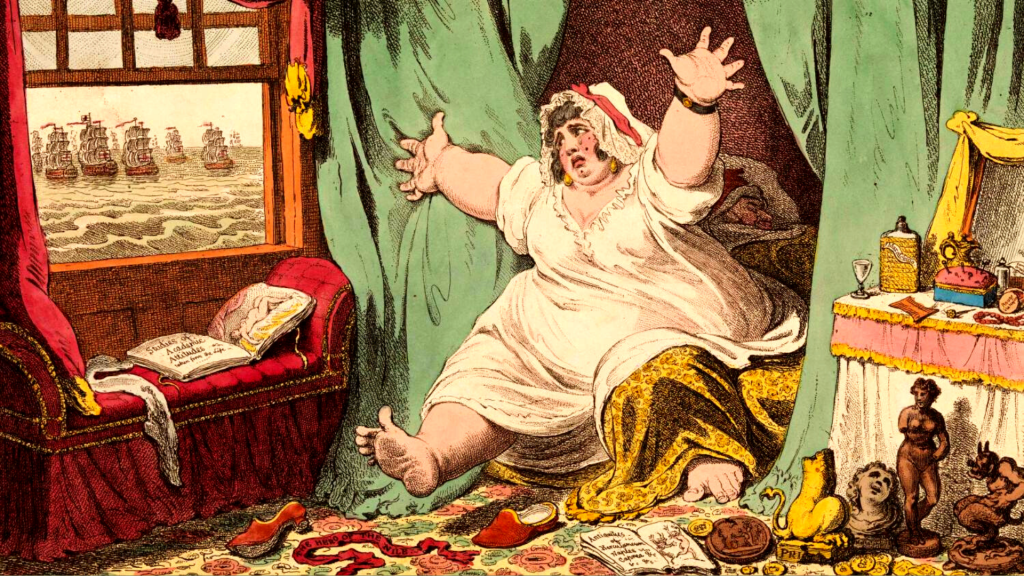It is a love story between a dashing superstar and a captivating beauty. But while history remembers him as a hero, Emma’s reputation was trashed
The story of Horatio Nelson may be filled with blood and honour, heroism and sacrifice but it is essentially an uncomplicated one, of a man on his ever-rising trajectory to greatness.
In this story Emma Hamilton is a margin note – the captivating lover that stole his heart and carried the daughter he could not acknowledge and would never really know.
As Nelson, after death, moved from national hero to deity – the embodiment of Empire itself – Emma became an irritating moral blot on the great man’s legacy.
So, a prudish Victorian society assigned her a new role – that of wanton temptress.
For Emma (1765-1815), the idea that her identity would be shaped by a society’s fascination and revulsion, would have come as no surprise. It was, in essence, the story of her life, a journey that is, in its way, as compelling, courageous and extraordinary as the life of her lover.
It is, also, an amazingly modern tale of a female celebrity and reinvention. Beauty encourages brashness, it elevates, then overshadows, true talent and, when beauty fades, all that went before is quickly condemned, as if the enchanted come to their senses and castigate the object of their fascination for their own dark impositions.
Treated like a possession
“A pretty woman is not always a fool,” she wrote. And yet she was gifted to her elderly husband like one of his antiquities.
“The prospect of possessing so delightful an object causes me some pleasing sensations,” wrote Sir William Hamilton to the man who, to be rid of her, had sent his lover as a mistress to his uncle.
Yet Sir William too would be dazzled by her, providing her with marriage, respectability and entry into regal circles. All this for a girl Emma born in dire poverty who may have been a child prostitute and certainly gave birth to a child in her early teens.
She was to captivate Europe with her beauty and achievements and was feted by kings and queens but the story was to have a tragic end as, abandoned by her society friends and branded an adulteress, she was imprisoned for debt and died in exile in Calais at the age of 49.
Woman of many faces
Dr Quintin Colville, author of Emma Hamilton: Seduction and Celebrity, said, “Emma Hamilton in the public mind is thoroughly associated with Nelson.
“It’s a very well entrenched stereotype which has some truth but which also conceals a far more complex, far more remarkable and far more spectacular life story in which her own talents, her risk-taking creativity has often been forgotten.
- Who was the real man behind the myth of Bounty’s cruel Captain Bligh?
- The curious case of a magic stone that caused ripples
“She is someone who is remarkably difficult to label. She moves between different personas and what we really want to do is replace simplicity with complexity in the sense that this is a remarkable woman with myriad faces.”
Born into poverty in the Wirral in 1765, Emma was the daughter of a blacksmith. She made her way to London at the age of 12 and, ambitious to a fault, she was drawn to Covent Garden where high culture and fashionable celebrity met a grimy underworld of sexual exploitation.
An artist’s muse
Emma became the lover of a young nobleman but was rejected by him when – aged 16 – she became pregnant. The future looked bleak until a new protector, Charles Greville, made provision for the child and introduced Emma to the artist George Romney.
With her innate theatricality and good looks, Emma found fame while still in her teens as Romney’s muse. During hundreds of sittings, he completed dozens of canvases. Many artists would follow in his footsteps making Emma one of the most painted women in British history.
Greville, however, longed for a wife, and Emma was a hindrance. A solution came in the form of his uncle – Sir William Hamilton, the British envoy in Naples.
Unknown to Emma, Greville convinced Hamilton to take her on as his own mistress. Emma was sent to Naples, expecting Greville to join her. When the truth became clear, she was crushed.
Traded to an older man
Determined to make the best of her circumstances, she threw herself into educational opportunities made available to her by Sir William.
She used her experience of modelling for Romney to create her own unique performance art: the “attitudes”; bringing to life the paintings and sculptures that enraptured the Grand Tourists in Naples.
Her poses and elegant use of costume and shawls became the must-see spectacle, winning the admiration of an elite audience that were all too ready to criticise a girl of Emma’s humble origins.
When she married the 61-year-old Sir William in 1791, Emma, 26, made a leap up the social ladder.
As the wife of an envoy, Lady Hamilton had a role to play in the Neapolitan Court becoming the favourite of Maria Carolina, Queen of Naples and Sicily.
In 1798, following a victory at the Battle of the Nile, Admiral Nelson arrived in Naples. Emma organised lavish celebrations in his honour. Later, with French forces approaching the city, Nelson arranged for the royal family to be taken on board his flagship and evacuated to Sicily.
Emma played a pivotal role on the journey.
The great love story
Emma and Nelson’s admiration turned to passion, and one of history’s greatest love affairs began.
With her lover and her husband Emma travelled back to Britain. However, Emma’s adulterous relationship with the nation’s hero risked the social status she had struggled so long to possess.
Rumours about their infidelity began to circulate back in England, where Nelson’s wife, Frances, awaited.

An 1801 caricature of the relationship
By now, Emma was also pregnant with Nelson’s child. Emma and Nelson dreamed of happiness, but the realities of life were more complex. Their daughter Horatia was born in secrecy and Emma could not admit to being her mother.
Emma found a country house, Merton Place, which she refurbished as her home with Nelson. But Nelson’s duties kept him away at sea for years at a time and his death at Trafalgar shattered Emma’s world. She was heartbroken, and never recovered. The famous uniform coat that he wore during the battle was arranged on her bed next to her grief-stricken form.
Her beauty faded, she never recovered
Without youthful beauty or the security of marriage, Emma’s fortunes never recovered either. Her life became increasingly difficult, made worse by her own desperate and extravagant efforts to maintain her lifestyle.
In 1813 she was arrested for debt and sent to King’s Bench Prison. After her release she spent her final months of failing health far from her creditors in Calais. She died in January 1815, broken and destitute. At every point of Emma’s journey, this dazzling woman fought through the barriers and conventions of a man’s world that she could never completely control.
Images
- Emma as Circe By George Romney – Tate Online
- An 1801 caricature of the relationship, Clive Richards Collection © National Maritime Museum, London

